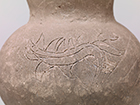Japanese Gallery (Honkan) Room T1
February 4, 2014 (Tue) - February 14, 2014 (Fri)
The Yayoi period (ca. 5th century BC–ca. 3rd century AD) was an agrarian society, in which rice-paddy cultivation was the basic means of food production. It was also a period when people began to make and use metalware. Rice cultivation was brought through the Korean peninsula to northern Kyushu, and is believed to have spread subsequently to the Kinki region--to Kobe, the Osaka plain, and the Nara basin. This exhibition introduces characteristics of the Kinki region fostered by the agrarian society, as seen in the representative items of the Yayoi period lent by the Osaka Prefectural Museum of Yayoi Culture. Most of these objects were excavated from Osaka's Funahashi and Ikegami-sone sites.
In the early Yayoi period, Ongagawa-style earthenware with common characteristics prevailed in western Japan. After the mid-Yayoi period, regional characteristics became increasingly evident not only in earthenware but in other types of ware including bronzeware. Typical objects from this period, which are featured in this exhibition, include a variety of dotaku bell-shaped bronzes and comb-marked earthenware with a magnificent yet delicate look. The exhibition also shows bronzeware unique to the region, such as Kinki-style dotaku and Osaka-bay–type bronze halberds. Lives of the people at the time are explored through excavated tools: stone reapers and polished stone axes, which were introduced to Japan with rice cultivation; polished stoneware including stone daggers; and fishing tools commonly found in the coastal regions of Osaka bay, such as octopus traps.
This exhibition, which is part of the museum's exchange program of archaeological objects in the fiscal year 2013, also aims to look into ancient people's prayers and views of the world through pictorial designs--dragons, people, and animals--on earthenware and bronzeware.
※This exhibition is closed for room maintenance.

